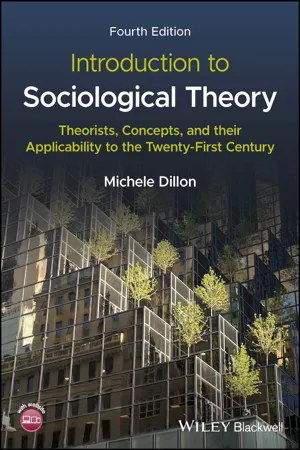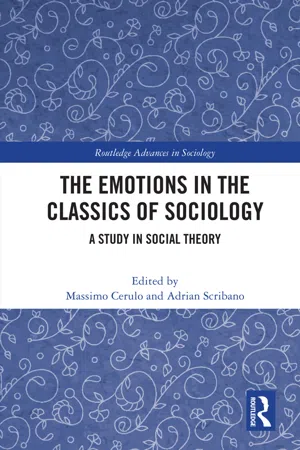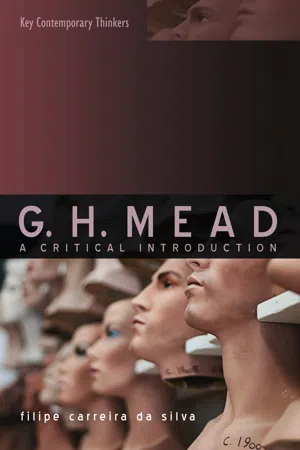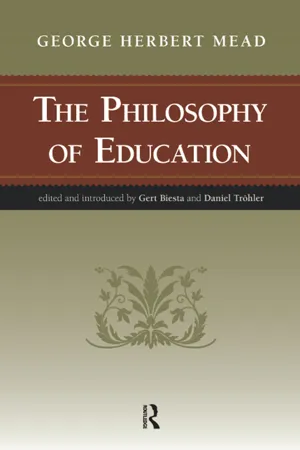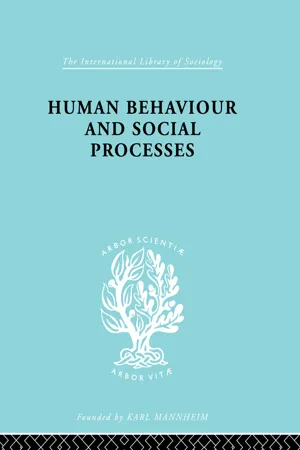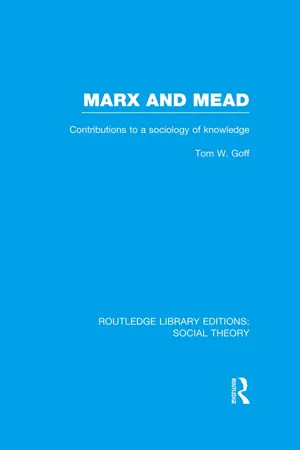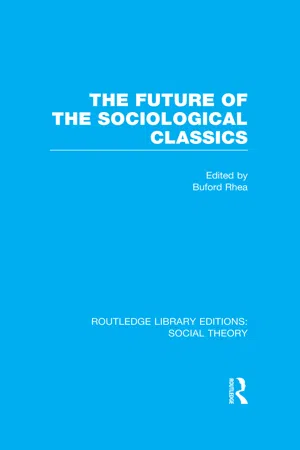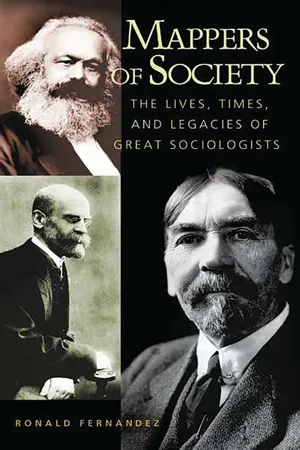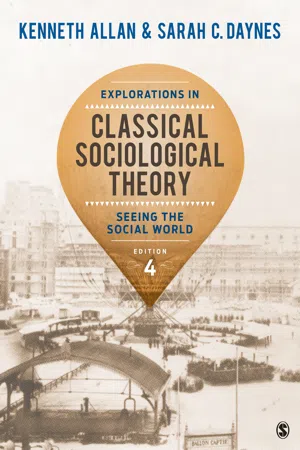Social Sciences
George H. Mead
George H. Mead was an influential American philosopher and sociologist known for his contributions to the field of symbolic interactionism. He emphasized the role of social interaction and communication in shaping individual identity and behavior. Mead's work laid the foundation for understanding the self as a product of social processes and the importance of language and symbols in human interaction.
Written by Perlego with AI-assistance
Related key terms
1 of 5
11 Key excerpts on "George H. Mead"
- eBook - PDF
Introduction to Sociological Theory
Theorists, Concepts, and their Applicability to the Twenty-First Century
- Michele Dillon(Author)
- 2024(Publication Date)
- Wiley-Blackwell(Publisher)
I know who I am and I know how to respond and behave in a given situation because I have learned from others’ attitudes BIOGRAPHICAL NOTE George Herbert Mead was born in South Hadley, Massachusetts, in 1863, into a strongly Protestant family. Mead, who was “shy, studious, and deferential to his parents” (Shalin 2000: 303), attended Oberlin College, then a Congregationalist institution, where he studied classics and moral philosophy. Although he thought about becoming a pas- tor, he eventually opted to pursue academic study at Harvard, where his professors included the philosopher Josiah Royce and the psychologist William James. Mead secured an academic position at the University of Michigan, where he became a close friend of his colleague, the philosopher John Dewey; both subsequently moved to the University of Chicago. Mead, who married Helen Castle, an heiress to the Dole Pineapple fortune, had a strong sense of social justice and was keenly interested in politics. He suffered, however, from “writer’s block,” a condition exaggerated by his anxiety about the originality and importance of his highly insightful approach to social interaction. Fortunately, his stu- dents, including Herbert Blumer, transcribed his lectures, thus making Mead’s thinking publicly accessible. Mead died in 1931 (Shalin 2000). 304 Symbolic Interactionism toward me (the self that I am aware of) and from how they behave (as selves) in a similar situation or in a common social activity or undertaking (1934: 155). Thus, Mead states, “The ‘I’ reacts to the self which arises through the taking of the attitudes of others. Through taking those attitudes we have introduced the ‘Me’ and we react to it as an ‘I’” (1934: 174); I see “Me” (as an object) through how others see me as indicated by their attitudes toward me. The “I” “is the response of the organism to the attitudes of others” (1934: 175). - eBook - ePub
The Emotions in the Classics of Sociology
A Study in Social Theory
- Massimo Cerulo, Adrian Scribano, Massimo Cerulo, Adrian Scribano(Authors)
- 2021(Publication Date)
- Routledge(Publisher)
Chapter 9 George Herbert Mead Lorenzo Bruni9.1 Introduction
George Herbert Mead (1863–1931) can be considered, for all intents and purposes, as a classic of sociological thought. This affirmation is not universally shared. Indeed, Mead is often defined primarily as a psychologist or a philosopher, and his standing as a sociologist has not always been accepted. Mead’s elevation to the canon as one of the leading lights of sociology has come about in two fundamental stages. Herbert Blumer and Jürgen Habermas are the two thinkers whose interpretive work has made the greatest contribution to Mead’s status as a sociological institution (see Côté, 2016 ; Huebner, 2014 ; Carreira da Silva, 2006 ).Blumer was the first to promote Mead’s canonization within the discipline of sociology (Blumer, 1981 ; 1969 ). The reception of Mead’s work on the part of the founder of symbolic interactionism is credited with laying the groundwork for the legitimization of Mead’s thought in the disciplinary field of sociology, providing the impulse for a substantial program of empirical research (see Carreira da Silva, 2006 ). Mead’s elevation to the status of an institutional figure in sociology was definitively certified by Jürgen Habermas and by the central role that he attributes to Mead in The Theory of Communicative Action (1987). Habermas, as is well known, makes ample reference to Meadian theory with the aim of formulating a sociological hypothesis on the social solidarity between strangers in the transition from a prevailing model of goal-orientated strategic action to a model of communicative action. The German sociologist credits Mead with being the sole artificer of a symbolically mediated theory of social interaction.Mead’s reflections on emotions are distinguished from other classic sociological formulations by one peculiarity. Like other sociologists, Mead believes that emotions are exquisitely social. But the characteristic feature of his conception is his proposal of a singular definition of the social dimension of emotions. For Mead, emotions are the raw material for the cognitive development of intersubjective human relations. Emotions constitute a sort of connective fabric, social in origin, between a dimension of feeling and a more cognitive dimension determined by human behaviour. - eBook - PDF
Social Constructionism
Sources and Stirrings in Theory and Practice
- Andy Lock, Tom Strong(Authors)
- 2010(Publication Date)
- Cambridge University Press(Publisher)
121 7 Meanings and perspectives George Herbert Mead and Jakob von Uexküll George Herbert Mead It is true, of course, that once mind has arisen in the social process it makes more possible the development of that process into much more complex forms of social interaction among the component individuals than was possible before it had arisen. But there is nothing odd about a product of a given process contributing to, or becoming an essential factor in, the further development of that process. The social process, then, does not depend for its origin or initial existence upon the existence and interactions of selves; though it does depend upon the latter for the higher stages of complexity and organization which it reaches after selves have arisen within it. (Mead, 1934: 226) As is common with thinkers of the first order, knowing quite where to start into Mead’s work is hard call. Mead did not concentrate on just one topic, but over the course of his lifetime produced an almost entire philosophy of everything. He deals with the self, the nature of society, the nature of history, the nature of objectivity, and other topics ad infinitum. His four books – The Philosophy of the Present ( 1932), Mind, Self, and Society ( 1934), Movements of Thought in the Nineteenth Century ( 1936) and The Philosophy of the Act ( 1938) – were con- structed from lecture notes made by his students during courses he taught, and all post-date his death. In the subtitle of his second book he styles himself as a ‘social behaviourist’, and in taking such a position he may appear an unlikely candidate for our purposes, but his concerns with the social nature of the construction of mind and meaning put him centre-stage. Important to our considerations of Mead is his pragmatism. Where many think- ers depict life in big picture and somewhat idealistic ways, Mead looked at how life ‘is done’ by the people living it. - eBook - ePub
G.H. Mead
A Critical Introduction
- Filipe Carreira da Silva(Author)
- 2013(Publication Date)
- Polity(Publisher)
1 Introduction and General OverviewA century has passed since George Herbert Mead (1863–1931) started working on the social theory that would grant him a place in the sociological canon, and yet his writings have lost none of their appeal. The reason why Mead’s ideas are after all these years still so engaging is, I argue, that the last two fins de siècle share certain structural similarities. Very much as in Mead’s time, Western modernity is experiencing today a sense of profound crisis, which follows a relatively long period of confidence in the rational mastery of social problems. In such epochs of crisis, the best theoretical instruments are those able to deal with change, uncertainty and hybridism. From this perspective, I think we have a lot to learn from Mead, perhaps the sociological classic who (with Simmel) best responded to the conceptual challenges posed by the first crisis of Western modernity. Rejecting the pessimism one can find in other classics’ writings (just recall Weber’s theses on bureaucratization or on the disenchantment of the modern world), Mead was confident that science and democracy could be reconciled in the form of a naturalistic and evolutionary social science, which conceives of the human mind as an ‘emergent’ from – that is, an entity resulting from – symbolic interaction.Among the sociological classics, Mead occupies a special position. Although he lived in the same epoch as all the other ‘founding fathers’ of sociology (he was five years younger than Durkheim and one year older than Weber), he is not only one of the few to have exerted a profound and lasting influence on a discipline other than his own, but also the only American to figure in that canonical gallery. In fact, Mead was not a sociologist; he was, by training, a philosopher with a strong interest in social psychology. The brilliance of his ideas on the social nature of the human self, however, ensured that in disciplines such as sociology and social psychology Mead is still seen today as one of the predecessors of their greatest practitioners. Unlike Marx, Weber or Durkheim, Mead was not a prolific writer. It was in the classroom, thinking aloud in the silent presence of his students, that Mead was at his best. This personal preference for the spoken word is very much in accord with the always ‘in-the-making’ nature of his intellectual edifice. Far from being a rigid, all-encompassing philosophical system, Mead’s thinking is best described as a system in a state of flux. - eBook - ePub
- George Herbert Mead, Gert J. J. Biesta, Daniel Trohler, Gert Biesta(Authors)
- 2015(Publication Date)
- Routledge(Publisher)
Introduction
George Herbert Mead and the Development of a Social Conception of Education Gert Biesta and Daniel TröhlerDOI: 10.4324/9781315632834-1George Herbert Mead was born on February 27, 1863, in South Hadley, Massachusetts. From 1869 onwards he lived in Oberlin, Ohio, where his father, a Congregational minister, was a professor at Oberlin Theological Seminary. In 1883 Mead graduated from Oberlin College. For the next four years he worked as a teacher, railroad surveyor, and private tutor before he moved to Harvard in 1887 to study philosophy with, among others, Josiah Royce. One year later Mead enrolled at the University of Leipzig where he studied philosophy with Wilhelm Wundt, Max Heinze, and Rudolf Seydel. Early in 1889 he moved on to the University of Berlin, where he studied philosophy, psychology, and education with, among others, Hermann Ebbinghaus, Wilhelm Dilthey, and Friedrich Paulsen. In 1891, before he managed to finish his Ph.D., Mead returned to the United States to take up a teaching position at the Department of Philosophy of the University of Michigan, Ann Arbor, where he worked under the chairmanship of John Dewey. In 1894 , Mead moved with Dewey to the University of Chicago, where he would continue to work until his death on April 26, 1931.Together with Charles S. Peirce, William James, and John Dewey, Mead is one of the founders of American pragmatism. Whereas Dewey and, to a lesser extent, James had a major impact on the theory and practice of education, Mead is most renowned for his work in philosophy and social psychology, particularly as the main source of inspiration for symbolic interactionism—the label Herbert Blumer gave to Mead’s work (Blumer 1969 ; Joas 1989 , 235). Mead did, however, have a practical interest in education which was stimulated by his collaboration with Dewey at the University of Chicago and which was part of his wider involvement in social reform in Chicago in the first decades of the twentieth century (Barry 1968 ; Cook 1993 ). Mead’s only son was enrolled in Dewey’s Laboratory School and for several years Mead served as president of the school’s Parents’ Association (Mead 1903 ). With his wife, Helen Castle, Mead edited Dewey’s lectures on the school, which were published in 1900 as The School and Society (Dewey [1900 ] 1976). Mead also contributed to two educational journals, School Review (Mead 1907 a) and Elementary School Teacher, of which he was an editorial board member from 1907–1909 (Mead 1907 –1908a; 1907–1908b ; 1908–1909b ; 1908–1909c ; 1908–1909d ; 1908–1909e ). From 1908 until 1914, Mead served as chairman of the Standing Committee on Public Education of the City Club of Chicago (Mead 1912 a). In this role he was actively involved in the writing of reports on the Chicago public library system, on vocational education in the Chicago public school system, and on the funding and administration of vocational education in the public schools of the state of Illinois (Mead, Wreidt, and Bogan 1912 - eBook - PDF
- George Ritzer, Barry Smart, George Ritzer, Barry Smart(Authors)
- 2001(Publication Date)
- SAGE Publications Ltd(Publisher)
He died on 26 April 1931, embittered by a dispute over university policy that had even led him to decide to abandon the university and the city where he had been so active. George Herbert Mead occupies a special position among those who are today recognized beyond dispute as the classical sociological theorists. By the time of his death he had not published a single book, and was scarcely known outside the circle of his students and immediate colleagues. Moreover, he had never actually taught in the sociology faculty: his life’s work was in the fields of philosophy and psychology, and his sociological influence was at first almost entirely limited to the course on social psy-chology that he gave for decades in Chicago. This course, which presented his specific approach to the subject, became part of socio-logical instruction at what was for a long time the most influential American department in the field. The posthumous publication of Mead’s writings, together with the compilation of stu-dents’ lecture notes in book form, has subse-quently established his reputation to an extent that is still growing today. The work In his foundations of social psychology, Mead starts not from the behaviour of the individual organism but from a cooperating group of dis-tinctively human organisms; not from an isolated, Crusoe-like actor who must first enter into social relationships and constitute collec-tively binding values, but from the complex activities of a group, from what he called the ‘social act’. Groups of human organisms are subject to conditions that differ fundamentally from those of pre-human stages. In contrast to insect colonies, for example, a strict division of labour is no longer assured through physiological differentiation. Even the regulation of group life by instinct-bound forms of behaviour which HANDBOOK OF SOCIAL THEORY 90 - eBook - ePub
Human Behavior and Social Processes
An Interactionist Approach
- Arnold M. Rose(Author)
- 2013(Publication Date)
- Routledge(Publisher)
A view of human society as symbolic interaction has been followed more than it has been formulated. Partial, usually fragmentary, statements of it are to be found in the writings of a number of eminent scholars, some inside the field of sociology and some outside. Among the former we may note such scholars as Charles Horton Cooley, W. I. Thomas, Robert E. Park, E. W. Burgess, Florian Znaniecki, Ellsworth Faris, and James Mickel Williams. Among those outside the discipline we may note William James, John Dewey, and George Herbert Mead. None of these scholars, in my judgment, has presented a systematic statement of the nature of human group life from the standpoint of symbolic interaction. Mead stands out among all of them in laying bare the fundamental premises of the approach, yet he did little to develop its methodological implications for sociological study. Students who seek to depict the position of symbolic interaction may easily give different pictures of it. What I have to present should be regarded as my personal version. My aim is to present the basic premises of the point of view and to develop their methodological consequences for the study of human group life.The term “symbolic interaction” refers, of course, to the peculiar and distinctive character of interaction as it takes place between human beings. The peculiarity consists in the fact that human beings interpret or “define” each other’s actions instead of merely reacting to each other’s actions. Their “response” is not made directly to the actions of one another but instead is based on the meaning which they attach to such actions. Thus, human interaction is mediated by the use of symbols, by interpretation, or by ascertaining the meaning of one another’s actions. This mediation is equivalent to inserting a process of interpretation between stimulus and response in the case of human behavior.The simple recognition that human beings interpret each other’s actions as the means of acting toward one another has permeated the thought and writings of many scholars of human conduct and of human group life. Yet few of them have endeavored to analyze what such interpretation implies about the nature of the human being or about the nature of human association. They are usually content with a mere recognition that “interpretation” should be caught by the student, or with a simple realization that symbols, such as cultural norms or values, must be introduced into their analyses. Only G. H. Mead, in my judgment, has sought to think through what the act of interpretation implies for an understanding of the human being, human action, and human association. The essentials of his analysis are so penetrating and profound and so important for an understanding of human group life that I wish to spell them out, even though briefly. - eBook - ePub
Marx and Mead (RLE Social Theory)
Contributions to a Sociology of Knowledge
- Tom Goff(Author)
- 2014(Publication Date)
- Routledge(Publisher)
129 He comprehends the truth of the results of scientific work as precisely the functional relationship of reconstructions to the needs of man as a social being. The predictive aspect of science is always temporally limited and contingent.IMPLICATIONS FOR INTERPRETATION OF THE SOCIAL THEORY OF MANThe criticisms of Mead’s theory of the development of mind and self, as that theory is presented in Mind, Self and Society , can be viewed as a refutation of the adequacy of his attempt to develop a synthesis of positivistic and idealist theories of human life. These criticisms concentrate on two specific issues. Briefly, it was shown that Mead’s introduction of the ‘I’ aspect of the self is not consistent with, nor logically integral to, his theory of self and mind as arising through an internalization of the prior, on-going social process in the form of conscious attitudes. The ‘I’ is considered as a residual category that is not explained within the theory of socialization, and is largely spoken of in terms of ‘chance’; the unexpected aspect of the actual response of the organism to the situation. Without the necessary elaboration, the individual is reducible, without contradiction, to the ‘me’ aspect of the self, to the internalized meanings present in his situation. Mead is quite clear in arguing that the self is continually undergoing change, but this is predicated strictly on changing responses of others and things to the specific individual.Second, it was demonstrated that the social process, out of which self and mind emerge is, in turn, reducible to a specific and predictable idea of an evolutionary process in nature. Mead clearly expresses the view, especially in the chapter entitled ‘Society’, that human history is an almost automatic expansion of universality; the gradual realization of a global community of common and shared attitudes, characterized by democratic government and a high development of functional social differentiation and interdependence. In fact, he argues that this predicted future follows precisely from the social-behaviouristic theory of mind and self that he develops, and that this future is indeed being realized. - Buford Rhea(Author)
- 2020(Publication Date)
- Routledge(Publisher)
7 George Herbert Mead HERBERT BLUMERThe decision to include a presentation of the thought of George Herbert Mead in a volume devoted to the future of sociological classics is both generous and foresightful. It is generous in that Mead’s thought cannot be said to have yet gained acceptance comparable with that of such figures as Comte, Durkheim, Weber, or Simmel. Mead’s thought, at best, has been lodged at the periphery of sociological concern. While a relatively small number of sociologists have sustained and fostered his views with vigor, the majority have given his thought a merely courteous nod of distant acquaintance. As happens so frequently in such circumstances remote acquaintance leads to inadequate comprehension, which here takes the form of a few stereotyped characterizations, such as that Mead’s thought is philosophical and not scientific, or that it deals only with the individual and not the group, or that it is ‘microsociological’ and not ‘macro-sociological’, or that it is a form of social psychology and not a form of sociology, or that it is merely a variant of phenomenology, or that it shortsightedly rejects the idea of social structure, or that it lacks any devices for the study of group life. It is not surprising that in being characterized in these ways Mead’s scheme of thought has been slighted by most sociologists as not worthy of serious consideration. For many sociologists Mead is a remote figure. For many other sociologists, especially non-American sociologists, Mead is an unknown figure. To include him among the present set of classical sociological figures might thus be seen as a charitable act.Yet, in my opinion, the decision to include Mead’s scheme of thought in the present volume is foresightful. There are strong prospects that his thought will attract increasing interest and adherence because of the distinctive way in which it ties together individual action and group life. Mead’s scheme centers on a picture of the human being which is quite different from that at the basis of the classical sociological approaches. Further, his picture of the human being as a participant in group life stands up exceptionally well when subjected to the rigors of empirical testing. This combination of uniqueness of perspective and of empirical validation appears to be bringing about increasingly serious consideration of Mead’s approach. With a better understanding of that approach there is good reason to expect that Mead’s scheme will come to occupy a recognized place in the standard body of sociological thought.1- eBook - PDF
Mappers of Society
The Lives, Times, and Legacies of Great Sociologists
- Ronald Fernández, Ronald Fernandez(Authors)
- 2003(Publication Date)
- Praeger(Publisher)
It is an eye opening adventure, revolving, like a carousel, around the concept of self. SELF There ought to be a law. Even if it is another Mead, Durkheim, or Sim- mel, no magnificent mind will ever again be allowed to publish a great book until and unless he or she precisely defines their terms at the very beginning of any long discussion. In Mead's case his students put his books together, so we could blame them if we choose to do so. But, whom- ever we throw the darts at, the problem remains: Mead offers no exact definition of the self. So, for us self is what you think of you. You could be lying to yourself; you could be firmly rooted in reality. Either way self refers to your conceptions of who you are as an object in the world of experience. 46 This is Mead's logic. If only because we use words to describe our selves, the self does not exist at birth. It arises in the process of social development and as a result of symbolic interaction with other people. Our parents are the most obvious and (in many instances) the most influ- ential others we encounter, but whoever first spoke to you about you initiated the process of your ongoing development of self. As values of American culture, advocates can applaud the self-made man or woman, all the while listening to Frank Sinatra croon "I did it my way." Meanwhile, Mead will answer with this: nonsense. Because we can- not develop a self unless others initiate the process, our lives are always— and forever—inextricably linked to the attitudes, beliefs, and values of other people. Like the famous Siamese twins, others and the developing self coexist from the first breath taken by any human being, anywhere on earth. 47 In distinguishing between the self and the body, Mead writes that a body can exist and function effectively without the existence of self. - eBook - ePub
Explorations in Classical Sociological Theory
Seeing the Social World
- Kenneth Allan, Sarah Daynes(Authors)
- 2016(Publication Date)
- SAGE Publications, Inc(Publisher)
It’s an internal conversation or symbolic interaction between the I and the Me through which we arrive at the meaning and evaluation we will give to our own behaviors, thoughts, and feelings, which we then thread together into a story we tell ourselves and others about who we are (the meaning of this particular social object). The self is initially created through successive stages of role taking and the internalization of language. This emphasis of Mead’s (1934) leads him to see society and social institutions as “nothing but an organization of attitudes which we all carry in us”; they are “organized forms of group or social activity—forms so organized that the individual members of society can act adequately and socially by taking the attitudes of others toward these activities” (pp. 211, 261–262). Society, then, doesn’t exist objectively outside the concrete interactions of people, as Durkheim or Marx would have it. Rather, society exists only as sets of attitudes, symbols, and imaginations that people may or may not use and modify in an interaction. In other words, society exists only as sets of potential generalized others with which we can role-take. The I and the Me Thus far, it would appear that the self is to be conceived of as a simple reflection of the society around it. But for Mead, the self isn’t merely this social robot; the self is an active process. Part of what we mean by the self is an internalized conversation, and by necessity interactions require more than one person. Mead thus postulates the existence of two interactive facets of the self: the I and the Me. The Me is the self that results from the progressive stages of role taking and is the perspective that we assume to view and analyze our own behaviors. The I is that part of the self that is unsocialized and spontaneous: “The self is essentially a social process going on with these two distinguishable phases
Index pages curate the most relevant extracts from our library of academic textbooks. They’ve been created using an in-house natural language model (NLM), each adding context and meaning to key research topics.
